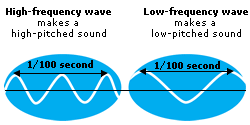DK Science: Pitch
Sound can be low-pitched, like the rumble of a large truck, or high-pitched, like a whistle. The pitch of a sound depends on the frequency of its wave. Piano keys produce notes that increase in pitch from the left side of the keyboard to the right. We can hear sounds of different pitches, but there are some sounds we cannot hear. Our ears cannot detect very low-pitched noises, known as infrasound, or very high-pitched noises, called ULTRASOUND.
Bats can hear frequencies up to 120,000 Hz. Other animals cannot hear such high-pitched sounds. Mice can hear frequencies up to 100,000 Hz, dogs up to 35,000 Hz, and cats up to 25,000 Hz. Humans hear sounds only up to about 17,000 Hz, but children can usually hear higher-frequency sounds than adults.
A racing car coming towards you bunches up the sound waves made by its engine. This makes them travel slightly faster. When the car passes by, the sound waves spread out and sound lower in pitch. This change in pitch is called the Doppler effect.
Sound waves with a frequency of 20,000 Hz or more are known as ultrasound. Humans cannot hear ultrasound, but bats, dogs, porpoises, and many other animals can easily detect it. Caused by things vibrating extremely quickly, ultrasound has many uses, from toothbrushes that clean your teeth with sound to submarine navigation.
Ultrasound allows doctors to check the health of a baby while it is still in the womb. High-frequency sound waves are sent into the mother’s body, where some reflect off the baby and bounce back to a receiver. A computer uses the reflected sound waves to create a scan (picture) of the growing baby.

